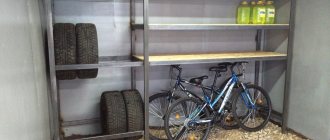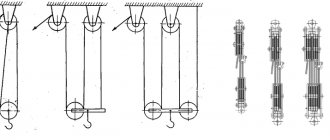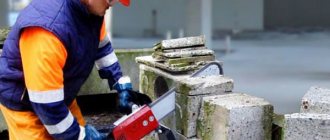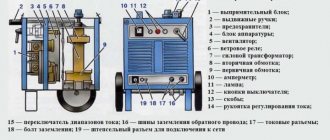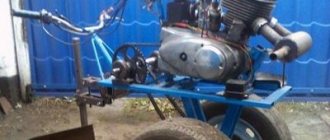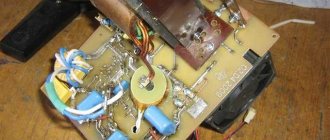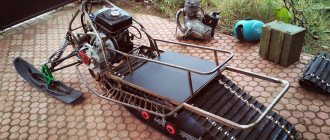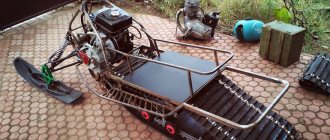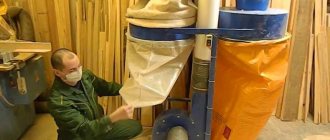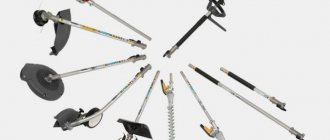As you know, our country is famous for its large number of woodworking industries. It is no secret that when processing wood, a lot of wood waste (sawdust, wood chips) remains, most of which is simply thrown away. However, it is woodworking waste that can often be used to organize the production of high-quality materials, one of which is wood concrete.
Arbolite or wood brick is an inexpensive and environmentally friendly building material used in the construction of low-rise buildings and structures, and also serves as insulation for load-bearing walls. The material itself is a block measuring approximately 500x250x200mm, consisting of a mixture of sawdust, cement, water and aluminum sulfate (or calcium chloride).
The main attractiveness of wood concrete is that most of the raw materials for its production are almost free (sawdust, sand, water). Thanks to this, low production costs are achieved, which allows you to receive additional profits. Moreover, organizing a business does not require many resources, labor or large production areas.
The production of wood concrete is beneficial for the following reasons:
- Low initial investment for starting a business;
- Low cost of finished products;
- Wood concrete is an inexpensive and environmentally friendly building material, the demand for which will only grow.
How much money do you need to start a wood concrete production business?
This business involves organizing a small mini-enterprise for the production of wood concrete with a production volume of 500 m3 of products per month. To organize the business, an investment of 900,000 rubles will be required.
The starting cost estimate is as follows:
- Mixing station – 120 thousand rubles;
- Molds (30 pieces) – 110 thousand rubles;
- A set of manual rammers – 15 thousand rubles;
- Drying chamber - 350 thousand rubles;
- Metal pallets – 30 thousand rubles;
- Wood chipper RRM-5 – 150 thousand rubles;
- Additional equipment (cement dispensers, wood chips) – 50 thousand rubles;
- Other expenses – 75 thousand rubles;
Total - 900 thousand rubles.
Technical equipment of the production workshop
The equipment of the enterprise must correspond to its calculated design capacity. Compact machines are suitable for small-scale production. Serial production of wood concrete products helps organize more productive equipment or production lines that combine several types of machines.
Equipment used
The following equipment can be used for various technological processes:
- chipping and crushing machines;
- mechanisms for mixing components;
- dispensers;
- vibrating presses;
- drying chambers.
For the smooth operation of the workshop, you will also need a sufficient number of molds of various sizes, pallets, racks, separators for obtaining several small wood concrete bricks in one mold, void formers and other equipment.
Where to start a wood concrete production business
To produce a product with a volume of 500 m3 per month, you will need to rent a premises with an area of at least 250 m2.
Thanks to the installation of a drying chamber in the room, the curing time of arbolite blocks is reduced to several hours.
The area of the room will be divided into:
- Production area – 50 m2;
- Holding and drying area – 100 m2;
- The storage area for finished products is 100 m2.
The company will operate one shift (8 hours) 5 days a week. The company's staffing will include 6 people: 4 general workers, an accountant and a sales and supply manager. A 2/2 shift work schedule will be established for general workers.
Table No. 1: Planned staffing at the enterprise
| Job title | Number of employees, people | Salary, rub./month. | Total, rub. |
| Handyman | 4 | 10 000 | 40 000 |
| Accountant | 1 | 15 000 | 15 000 |
| Purchasing Manager | 1 | 15 000 | 15 000 |
| TOTAL | 6 | — | 70 000 |
Advantages of arbolite blocks
Arbolite, as a building material, has a number of advantages, which include:
- Arbolite is an environmentally friendly building material;
- The thickness of the wood concrete is only 30 cm, but at the same time its heat-insulating and sound-proofing properties are higher than a wall three bricks thick (75 cm);
- Easily subjected to any mechanical processing, be it sawing, grinding, drilling, etc.;
- Wood concrete blocks, unlike wood, are not subject to rotting processes or infection by fungi and other microorganisms;
- The construction of buildings and structures using arbolite blocks takes place in the shortest possible time with the least expenditure of effort and financial resources;
- High fire resistance allows it to be used for the construction of facilities with increased fire safety requirements;
- Refers to a lightweight building material. Its weight is much less than that of most other building materials;
- Thanks to its large-porous structure, improved air exchange and humidity levels in the room are ensured;
- Houses built from wood concrete are characterized by increased durability and their service life significantly exceeds human needs.
Equipment for the production of wood concrete
The main equipment for organizing production includes:
- Mixing station, (3 cubic meters) for the preparation of wood concrete mass;
- Molds for the production of blocks of a given size (300*200*500 mm, 500x250x200mm, etc.);
- A set of manual rammers or equipment for vibration compaction.
The list of additional equipment includes:
- Drying chamber for faster curing of arbolite blocks;
- Chips for chopping large chips;
- Receiving hopper for feeding wood chips to the mixing station;
- Conveyors for delivering wood concrete mixture to areas for vibration compaction;
- Metal pallets for finished blocks.
The main raw materials for the production of wood concrete blocks per 1 m3 are:
- Wood chips – 1166 liters. In this case, the wood chips should not be freshly cut; it must be previously stored under a canopy;
- Aluminum sulfate solution – 112 liters (90 kg of dry matter per 1000 liters of water);
- Cement – 237 liters;
- Water depending on the moisture content of the chips. Water must be added until the mixture begins to shine.
Accordingly, to produce 500 m3 of wood concrete blocks per month you will need:
- Chips: 583 thousand liters of wood chips;
- Aluminum sulfate solution: 56 thousand liters;
- Cement: 118 thousand liters.
Briefly about the main thing
Producing high-quality wood concrete at home is not an extraordinary task. The only serious difficulty may be finding a wood chipper. In extreme cases, it can be made or ordered, but if there is somewhere to buy ready-made wood chips, then this problem is solved.
The wood chips used should be kept in the sun for about a month to neutralize the organic matter inside them. You can also use it when wet for the solution.
There are two main methods for stripping finished blocks. To choose the right one, it makes sense to make trial blocks and compare the results.
Technology for the production of wood concrete blocks
- Loading chips into the mixing station, turning on the drive and adding aluminum sulfate (or calcium chloride). The screws of the mixing station split the wood chips to the required sizes and neutralize the sugars in the wood chips using aluminum sulfate.
- After splitting the wood chips, water and cement are added to the mixing station and the final mixing of the wood concrete mixture occurs.
- The finished wood concrete mixture is transported to the compaction site and loaded into molds. Compaction occurs using manual tampers or by vibrating with a weight.
- Once compaction is complete, the blocks are removed from the molds. The finished blocks should be kept for at least 2-4 days, after which they can be freely moved and stacked one on top of the other. Arbolite blocks can be placed on pallets up to 2 m high after 7 days. The blocks acquire their final density only after a month. When using a drying chamber, wood concrete blocks are ready for construction immediately after removal from the chamber, which significantly reduces the use of additional storage facilities.
Making molds for concrete
Mold for arbolite blocks.
To produce sawdust concrete blocks you will need molds. If you plan to produce large-sized material, then it is better to make the molds detachable. For small blocks, forms that have a cellular structure are suitable.
The molds are made from 2 cm thick boards, which are covered inside with sheet steel. Thanks to the presence of metal, maximum waterproofing is achieved. The boards should not absorb moisture from the working mixture. In addition, molds lined with sheet steel make it easier to remove completed blocks.
If you decide to use forms without steel, then before laying the prepared mixture and during the process of making blocks, the structure is abundantly moistened. Sawdust concrete should not be allowed to dry out prematurely.
When making molds, one more nuance should be taken into account. When dried, the mixture shrinks and the material becomes slightly smaller in size. Therefore, if you plan to make material of a certain size, then the dimensions of the mold should be 10% larger than the blocks.
Wooden forms are placed on plastic or metal pallets, which are covered with a thin layer of sawdust. If you need to make internal holes in sawdust concrete, then the mold should contain sheets of roofing felt, rolled into a tube. To speed up the production process, 15-20 molds are created at once. This will significantly save time for subsequent construction work.
How much can you earn from the production of wood concrete blocks?
One of the main tasks when organizing this business is to find channels for selling finished products. In order to ensure that wood concrete blocks do not linger in the warehouse, it is necessary to think in advance about the points of sale of manufactured products and plan the monthly production volume based on the current demand for the product. The main sales season for crossbow blocks begins in spring and ends in autumn. The retail price for 1 m3 is from 4,000 thousand rubles. Wholesale price – from 2500 per 1 m3. Sales of finished products are possible in the following ways:
- Sale of blocks to large wholesale resellers;
- Sales of products at retail prices to the public for individual construction;
- Concluding contracts for the supply of wood concrete blocks to construction organizations;
- Sale of blocks in small wholesale to organizations involved in the sale of building materials (construction markets, hypermarkets).
First stage. The importance of proper business organization
Having decided on the type of future business, you need to draw up a detailed business plan taking into account demand, the required assortment, possible competition, the availability of raw materials, the expected tax burden and other important points. The feasibility of the project must be confirmed by the necessary economic calculations.
The organization of production begins with the registration of a new enterprise or individual entrepreneur. At the same time, the location and area of the production complex is determined. Its territory should accommodate the main workshop, auxiliary premises, staff rooms, warehouses for raw materials and finished products.
Acquisition, installation, adjustment of equipment capable of ensuring the production of the estimated volume of products is the next stage. At the same time, a working team is formed and trained, wood concrete production technology is studied, and a raw material reserve is created for a monthly (minimum) load of the enterprise at full capacity.
How much money do you need to start a business producing wood concrete blocks?
Let's calculate the monthly expenses of an enterprise producing 500 m3 of finished products per month:
- Rent of premises 250m2 – 80 thousand rubles;
- Costs for raw materials (cement, aluminum sulfate, wood chips) – 800 thousand rubles;
- Utility costs (water, heating, electricity) – 40 thousand rubles;
- Salary and insurance contributions – 90 thousand rubles;
- Taxes (USN 6% of gross income) – 90 thousand rubles;
- Advertising – 10 thousand rubles;
- Other expenses – 50 thousand rubles.
Total expenses: 1,260,000 rubles per month Next, let’s calculate the monthly income of an enterprise producing 500 m3 of wood concrete per month. It is planned to sell the entire volume of produced products monthly, that is, 500 m3 of wood concrete blocks. It is assumed that of the total volume of products produced, 70% will be sold at a wholesale price (2,500 rubles/m3) and 30% at a retail price (4,000 rubles/m3). The total amount of revenue will be 1,475,000 rubles per month.
Economic performance indicators of the enterprise (month): Gross income - 1,475,000 rubles Expenses - 1,160,000 rubles Profit - 315,000 rubles Profitability - 27% Payback of the project - only 2.5 months
Choosing a tax system
To conduct business and earn income, mandatory state registration is required. After registering as an individual entrepreneur (IP), individuals have the opportunity to independently choose the taxation system for their activities after making comparative calculations.
The following criteria are taken into account:
- requirements of a specific taxation option;
- scale of production;
- expected income;
- availability of hired workers;
- special regional rates and benefits;
- other features.
In practice, the most beneficial for individual entrepreneurs is the simplified taxation system (STS), which involves two options for calculating the tax charged. The amount of tax payments can be 6% of income (costs are not taken into account) or 5-15% of net income (the difference between income and expenses). Under which option the tax burden will be less, the entrepreneur decides for himself.
Permissions to open
To open the production of wood concrete, an operating license is not required. But it is necessary to obtain permission from Rospotrebnadzor. For this purpose, the following documents must be provided:
- registration documents;
- a production control program, which indicates how the requirements of the SES are fulfilled;
- an agreement with a company for solid waste disposal;
- an agreement with a company for the recycling of fluorescent lamps;
- premises rental agreement;
- documents for purchased equipment;
- production flow chart.
In addition, you must obtain permission from the fire department. The rental agreement for the premises must be concluded for a long term.
(
1 ratings, average: 5.00 out of 5)
Loading…
Similar business ideas:
- Sawdust recycling as a business idea
- TOP 30 business ideas with minimal investment
- TOP 30 business ideas without investment
- The best business ideas for a village
